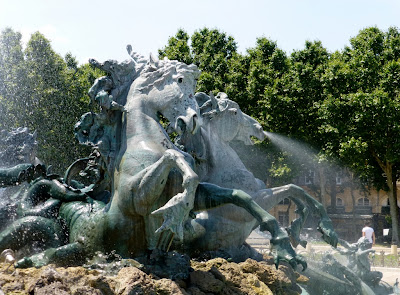Ce n’est pas facile, la vie des retraités! Partir de Carlux à 6h, retour 22h. Un peu de dodo dans le car, et puis la ville de Bordeaux à explorer. Croisière le matin, déjeuner, et puis beaucoup (un peu trop) de marche l’après-midi. Malgré la pluie pendant la semaine (et le lendemain) il a fait très beau.
Not easy being retired! The bus left at 6 a.m., returned at
10 p.m. A little sleep on the way, and
then the city of Bordeaux to explore. We
had a short ‘cruise’ on the river in the morning, lunch, and then lots of
walking around the city. Although it
rained most of the week (and the next day) we had lots of sun.
Deux beaux ponts
sur la Garonne.Two beautiful bridges over the Garonne.
Le Pont de Pierre, construit en 1822, avec ses
17 arches (le nombre de lettres dans ‘Napoléon Bonaparte)
The Pont de Pierre, or stone bridge, built in 1822, with its
17 arches – apparently the number of letters in ‘Napoleon Bonaparte’
Le tout nouveau Pont Jacques-Chaban-Delmas,
un pont levant, ouvert il y a quelques semaines.
The brand new Jacques-Chaban-Delmas, opened only a few weeks
ago. It is a kind of drawbridge, with
the entire centre of the bridge moving up the columns. Chaban-Delmas was born
Jacques Delmas, but his nom de guerre in the resistance was Chaban, and after
the war he changed his legal name to reflect this. He was a government minister for many years, Prime
Minister from 1969 to 1972, and mayor of Bordeaux from 1947 to 1995. (Yes, in
France you can have several positions at the same time, and many mayors serve
very long terms.)
Beaucoup de sculptures dans la ville. Ici, 'Ne rien dire', un de trois, evidemment.
Lots of sculptures. Here, 'Speak no evil', one of three - obviously
Près du Grand Théâtre. Near the Grand Théâtre.

Et quelque part d'autre. And somewhere else.
La fontaine dans la Place des Quinconces.
Les groupes en
bronze ont été enlevés par les Allemands à la recherche de métaux, mais ‘retrouvés
à Angers en 1945, et remis en place en 1986.
The figures in the fountain are made of bronze, and in WWII
were removed by the Nazis, to re-use the metal.
However the train carrying them was diverted by the Resistance, and the sculptures
were found in 1945 in Angers – it took until 1986 for them to be restored to
the fountain.
Les groupes en
bronze ont été enlevés par les Allemands à la recherche de métaux, mais ‘retrouvés
à Angers en 1945, et remis en place en 1986.
La Gironde et La
Dordogne forment La Garonne – ici une représentation de la Dordogne, avec son
canard.
The Garonne is formed by the union of the Dordogne and the
Gironde rivers. On one side of the
fountain is a representation of the Dordogne with a duck – even then.
Une rosace - vide. A rose window, with no glass.
Et quelques vues de la vie a Bordeaux. Some more ordinary scenes of life in Bordeaux.

.jpg)
.jpg)
.jpg)

.jpg)

.jpg)
.jpg)
.jpg)
.jpg)